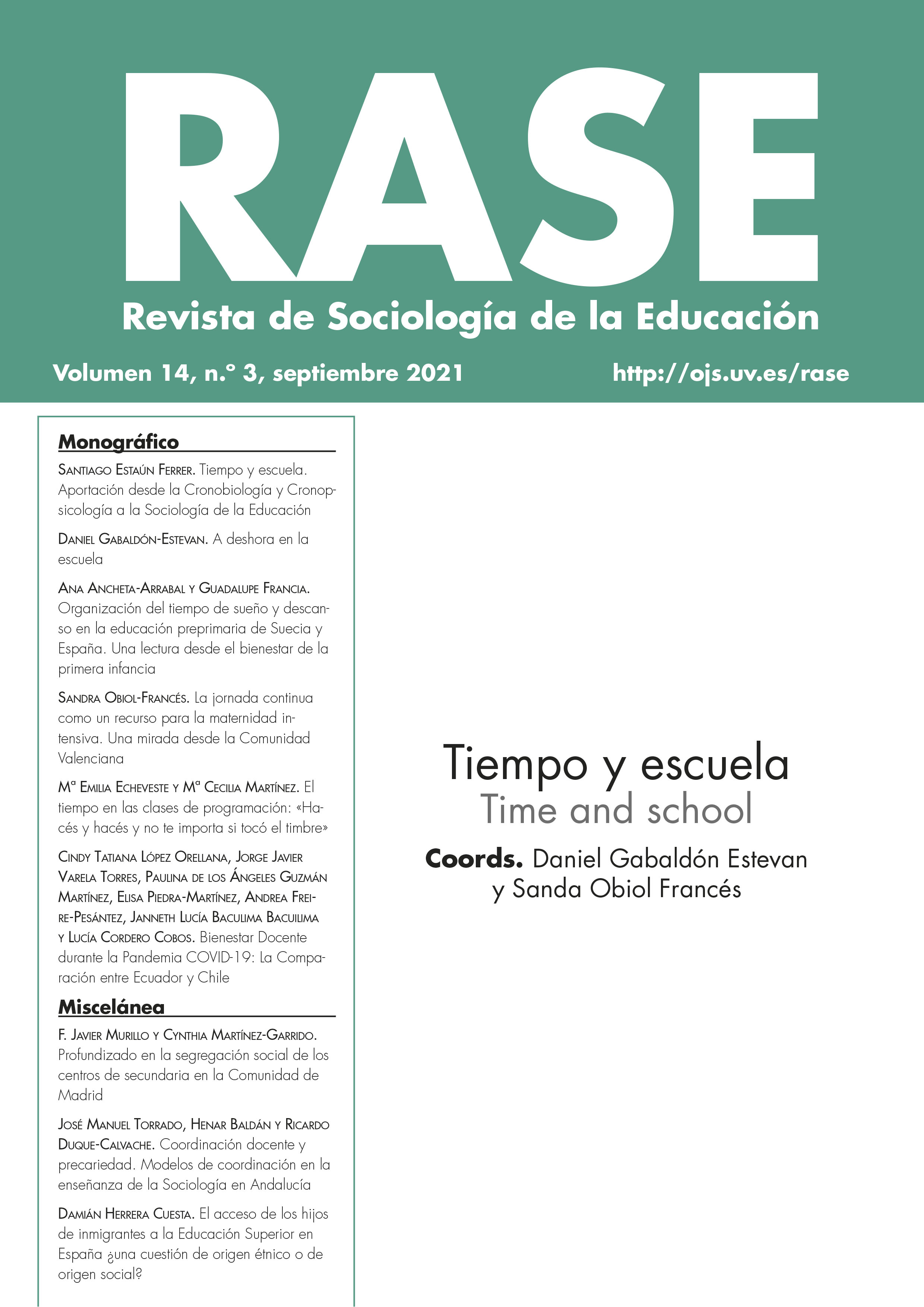Untimely School Hours
DOI:
https://doi.org/10.7203/RASE.14.3.21626Keywords:
horario escolar, cronotipo, jetlag social, jornada escolar Abstract
Abstract
The growing body of evidence in the chronobiology and chronomedicine literatures questions whether the organization of school learning times takes account of biological time and, in particular, in relation to time for rest and eating, and the academic activity- alertness-fatigue cycles. In the fields of both health studies and education concern is growing concern over the consequences for health and academic performance of a per-manent mismatch between the social clock and students’ internal clocks. In this article, we conduct a comparative study of European school schedules in relation to local solar time in each state from a sociological perspective. This is the first study to adopt this lens and it reveals some interesting data related to school day start times and lunch break times in Europe. It recommends reforms to education hours in order to achieve education systems that respect the health and well-being of students and, thus, allow greater and more efficient use of educational resources.
 Downloads
Downloads
 References
References
Ancheta Arrabal, A., Quiroz, Y. del M., & Gabaldón Estevan, D. (2019). Organización del tiempo y la jornada escolar en España: Análisis comparativo de la disparidad territorial en la Educación Obligatoria. In J. A. Marín Marín, G. Gómez García, M. Ramos Navas-Parejo, and N. Campos Soto (eds.) Inclusión, Tecnología y Sociedad: investigación e innovación en educación, Dykinson, pp. 1897–1910
Azevedo, C. V., Sousa, I., Paul, K., MacLeish, M. Y., Mondéjar, M. T., Sarabia, J. A., ... & Madrid, J. A. (2008). Teaching chronobiology and sleep habits in school and university. Mind, Brain, and education, 2(1), 34-47.
Clara, M. I., & Gomes, A. A. (2020). An epidemiological study of sleep− wake timings in school children from 4 to 11 years old: Insights on the sleep phase shift and implications for the school starting times' debate. Sleep medicine, 66, 51-60
Dunster, G. P., de la Iglesia, L., Ben-Hamo, M., Nave, C., Fleischer, J. G., Panda, S., & Horacio, O. (2018). Sleepmore in Seattle: Later school start times are associated with more sleep and better performance in high school students. Science Advances, 4(12), eaau6200.
Egido Gálvez, I. (2011). Los tiempos escolares en los sistemas educativos: análisis de algunas reformas recientes. Revista española de educación comparada.
Gabaldón-Estevan, D.; Ancheta Arrabal, A. y Obiol Francés, S. (2021): "La organización del tiempo escolar en Europa" en Inmaculada Aznar Díaz y otros (eds.): Desempeño docente y formación en competencia digital en la era SARS COV 2. Madrid: Dykinson
Gabaldón Estevan, D. (2020). Horizontes de innovación y transformación de los tiempos escolares. In M. Fernández Enguita (ed.) La organización escolar. Repensar la caja negra para poder salir de ella. Madrid: ANELE-Rede.
Gabaldón-Estevan, D., & Täht, K. (2020). The school schedule effect on self-reported sleep length of children and youth in Spain. Journal Sleep Research, 29, 180–180
Gabaldón-Estevan, D., y Obiol-Francés, S. (2017). Guía sobre tiempos escolares. Creativity and Educational Innovation Review, (1), 12-69.
Garaulet, M. (2017). Los relojes de tu vida. Barcelona, España: Paidós.
García, E. (2004) Medio ambiente y sociedad. La civilización industrial y los límites del planeta. Madrid: Alianza Editorial.
Gromada, A. y Shewbridge, C. (2016), Student Learning Time: A Literature Review, OECD Education Working Papers, No. 127, OECD Publishing, Paris. DOI: http://dx.doi.org/10.1787/5jm409kqqkjh-en
Kamette, F. (2011). Organisation of school time in the European Union. European issues, (212), 1-6.
Kelley, P., Lockley, S. W., Foster, R. G., & Kelley, J. (2015). Synchronizing education to adolescent biology: ‘let teens sleep, start school later’. Learning, Media and Technology, 40(2), 210-226.
Klein, J. (2004) Planning middle school schedules for improved attention and achievement, Scandinavian Journal of Educational Research, 48:4, 441-450, DOI: 10.1080/0031383042000245825
Lázaro, L. (2004). El tiempo escolar en la Unión Europea. Organización del calendario y la jornada escolar. Aula. Revista de enseñanza e investigaciones educativas, Salamanca, 12, 185-202.
Lázaro, L. (2012). La perspectiva social de la jornada escolar en la unión europea: Estudio comparado en Italia, Francia, Portugal y España. Revista Española de Educación Comparada, (19), 193-218.
Parente, C. D. M. D. (2020). Compared analysis of the school day in European union countries. Cadernos de Pesquisa, 50, 78-94.
Pin Arboledas, G., Gradolí Guillem, R., y García Martí, G., (2016) Sleep Habits in Students Performance (SHASTU). Disponible en http://shastu.org/wp-content/uploads/2017/02/SHASTU-FINAL-REPORT-ENGLISH_ok.pdf
Reis, C. (8 noviembre de 2019). Social Clocks - examples from Europe, seasons and lifespan [Vídeo]. 1st International Workshop on Time Studies in Childhood and Youth, València, España. https://ansolab.blogs.uv.es/1st-international-workshop/
Roenneberg, T. (2012). Internal time. Harvard University Press.
Roenneberg, T., Kuehnle, T., Pramstaller, P. P., Ricken, J., Havel, M., Guth, A., y Merrow, M. (2004). A marker for the end of adolescence. Current biology, 14(24), R1038-R1039.
Roenneberg, T., Winnebeck, E. C., & Klerman, E. B. (2019). Daylight Saving Time and Artificial Time Zones –A Battle Between Biological and Social Times. Frontiers in Physiology, 10(944).
Saxvig, I. W., Bjorvatn, B., Hysing, M., Sivertsen, B., Gradisar, M., & Pallesen, S. (2021). Sleep in older adolescents. Results from a large cross‐sectional, population‐based study. Journal of Sleep Research, 30(4), e13263.
Simpkin, C. T., Jenni, O. G., Carskadon, M. A., Wright Jr, K. P., Akacem, L. D., Garlo, K. G., & LeBourgeois, M. K. (2014). Chronotype is associated with the timing of the circadian clock and sleep in toddlers. Journal of sleep research, 23(4), 397-405.
Tarokh, L., & Vyazovskiy, V. V. (2021). Too sleepy for school: is sleep in teenagers homeostatically regulated under chronic sleep restriction? Sleep, 44(9), 1-3.
Tenti, Emilio (coor.) (2010). Estado del arte: escolaridad primaria y jornada escolar en el contexto internacional. Estudio de casos en Europa y América Latina. IIPE-UNESCO: Buenos Aires
van der Vinne, V., Zerbini, G., Siersema, A., Pieper, A., Merrow, M., Hut, R. A., ... y Kantermann, T. (2015). Timing of examinations affects school performance differently in early and late chronotypes. Journal of biological rhythms, 30(1), 53-60.
Zerbini, G., & Merrow, M. (2017). Time to learn: H ow chronotype impacts education. PsyCh journal, 6(4), 263-276.
Zerbini, G., van der Vinne, V., Otto, L. K., Kantermann, T., Krijnen, W. P., Roenneberg, T., y Merrow, M. (2017). Lower school performance in late chronotypes: underlying factors and mechanisms. Scientific reports, 7(1), 4385.
Downloads
Published
How to Cite
-
Abstract1341
-
PDF (Español)600
Issue
Section
License
![]()
This work is licensed under a Creative Commons Reconocimiento-NoComercial-CompartirIgual 4.0 Internacional.




